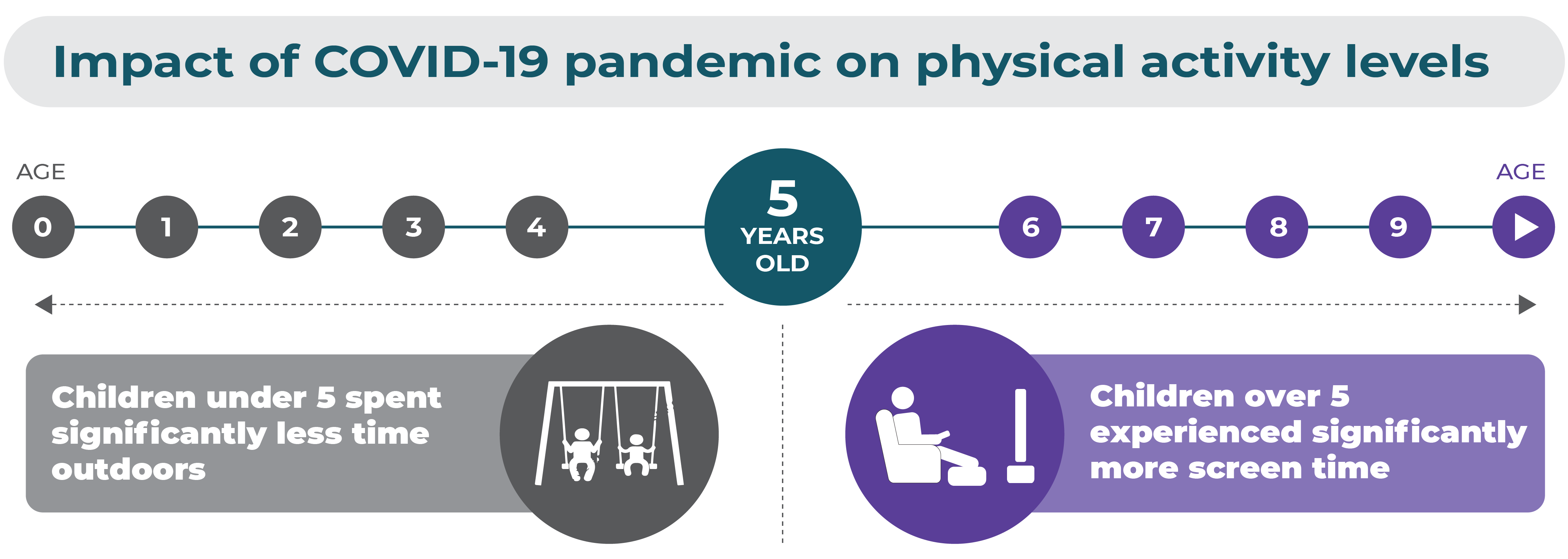Physical activity policies

Physical activity levels during the COVID-19 pandemic
COVID-19 pandemic restrictions saw significant shifts in physical activity levels and opportunities.
- The impact of public health measures among children in Canada found that those under 5 years old experienced significantly reduced time outdoors and those over 5 experienced significantly increased screen time.1
- During the pandemic, 53% of parents of 5–11-year-olds indicated reduced play at parks, 54% indicated decreased play in public spaces, and 59% reported increased time watching TV, playing video games (56%), and using screen-based devices (76%).2
- A minority of children experienced increased outdoor activity during the pandemic. These children were more likely to come from a high-income household, live in a low-density neighbourhood or live close to a park, live in a house rather than an apartment, or live far away from a major road.3
- Among a national sample of children and youth in Canada in 2020, more than 80% were not meeting physical activity guidelines and 89% had higher screen time than recommended.4
- Youth aged 12-17 and adults aged 65+ were less likely to meet physical activity guidelines during the pandemic.5
- Among adults in Canada, one study reported a 20% decrease in those meeting international guidelines for moderate to physical activity per day from pre-COVID-19 levels to during the early months of the pandemic.6
- 40% of previously inactive adults became less active and 22% of previously active individuals became less active during the early months of the pandemic.7
- A significant increase in the active use of parks, open spaces, and natural areas was seen throughout the pandemic. As an example, a reported increase of 175% was seen in the Metro Vancouver Region.8
Physical activity policy shifts during the COVID-19 pandemic
COVID-19 pandemic restrictions along with funds and resource redeployments have disrupted numerous areas of physical activity including active transportation needs and opportunities; actively designed urban centres; delays in built infrastructure such as community centres and outdoor fitness facilities; lack of physical activity programming, sports teams, and sports clubs in schools; and fewer public education campaigns.
![]() Negative interventions throughout the pandemic included closures of schools resulting in missed physical education classes; ceased operation of sports teams, recreational programming, and sports clubs; closure of recreation centres, pools, ice pads, fitness centres, and gyms; closure of outdoor spaces including sports fields and playgrounds; and stark reduction of public transit use during initial pandemic waves.
Negative interventions throughout the pandemic included closures of schools resulting in missed physical education classes; ceased operation of sports teams, recreational programming, and sports clubs; closure of recreation centres, pools, ice pads, fitness centres, and gyms; closure of outdoor spaces including sports fields and playgrounds; and stark reduction of public transit use during initial pandemic waves.
![]() Positive interventions throughout the pandemic included an increase in cycling networks and infrastructure across some jurisdictions, initiating open street policies, and revitalization of green spaces, with some of these initiatives made permanent.
Positive interventions throughout the pandemic included an increase in cycling networks and infrastructure across some jurisdictions, initiating open street policies, and revitalization of green spaces, with some of these initiatives made permanent.
COVID-19 pandemic recovery and physical activity
- Additional strategies to support people to revert to previous, higher levels of physical activity along with those just beginning physical activity pursuits are necessary, including the development of new guidance on how to stay active given potentially ongoing public health measures such as physical distancing and face masking.
- Improving accessibility to physically active opportunities need to be a core element in the pandemic recovery to ensure communities are more accessible, inclusive and equitable for every ability.
- Further consideration of the impact of the COVID-19 pandemic on physical activity and sedentary behaviours across all age groups, gender and sociodemographic factors is needed.
- Planners need to consider the probability of long-term remote working which could have significant impacts on public transit use, neighbourhood health, reduced park space, and a more auto-centric design.9
- Regardless the aim of a policy, all levels of government should be notified and/or engaged. Maneuvering through multiple levels of government can present challenges but can often result in more robust and sustainable policy decisions.

Further research on physical activity policy
- More information is needed to address priority populations and ensure population-level interventions are chosen and implemented with a health equity lens to not further exacerbate health disparities.
- Well-designed studies with objective measurement of physical activity or sedentary time, and appropriate control for confounding are needed to be more certain in the effectiveness of active transport, active urban design, and sport and recreation.
COVID-19 pandemic recovery and physical activity
The need for innovative policy approaches to increase physical activity levels are needed as Canadians emerge from COVID-19 pandemic restrictions.
-
References
1 - Li, X., Vanderloo, L.M., Maguire, J.L., Keown-Stoneman, C.D.G., Aglipay, M., Anderson, L.N., Cost, K.T., … TARGet Kids! Collaboration. 2021. Public health preventive measures and child health behaviours during COVID-19: A cohort study. Canadian Journal of Public Health 112: 831-842. https://link.springer.com/content/pdf/10.17269/s41997-021-00549-w.pdf
2 - McCormack, G.R., Doyle-Baker, P.K., Petersen, J.A., & Ghoneim, D. 2020. Parent anxiety and perceptions of their child’s physical activity and sedentary behaviour during the COVID-19 pandemic in Canada. Preventive Medicine Reports 20: 101275. https://www.sciencedirect.com/science/article/pii/S2211335520302333
3 - Mitra, R., Moore, S.A., Gillespie, M., Faulkner, G., Vanderloo, L.M., Chulak-Bozzer, T., … Tremblay M.S. 2020. Healthy movement behaviours in children and youth during the COVID-19 pandemic: Exploring the role of the neighbourhood environment. Health and Place 65: 102418.
4 - Moore, S.A., Faulkner, G., Rhodes, R.E., Brussoni, M., Chulak-Bozzer, T., Ferguson, L.J., … Tremblay, M.S. 2020. Impact of the COVID-19 virus outbreak on movement and play behaviours of Canadian children and youth: a national survey. International Journal of Behavioral Nutrition and Physical Activity 17(85). https://ijbnpa.biomedcentral.com/articles/10.1186/s12966-020-00987-8
5 - Watt, J. & Colley, R.C. 2021, September 17. Youth—but not adults—reported less physical activity during the COVID-19 pandemic. Statistics Canada. https://www150.statcan.gc.ca/n1/en/pub/45-28-0001/2021001/article/00032-eng.pdf?st=N-OBgxca
6 - Rhodes, R. E., Liu, S., Lithopoulos, A., Zhang, C. Q., & Garcia-Barrera, M. A. 2020. Correlates of Perceived Physical Activity Transitions during the COVID-19 Pandemic among Canadian Adults. Applied psychology. Health and well-being, 12(4), 1157–1182. https://iaap-journals.onlinelibrary.wiley.com/doi/10.1111/aphw.12236
7 - Lesser, I. A. & Nienhuis, C. P. 2020. The Impact of COVID-19 on Physical Activity Behavior and Well-Being of Canadians. International journal of environmental research and public health, 17(11), 3899. https://doi.org/10.3390/ijerph17113899 https://www.mdpi.com/1660-4601/17/11/3899
8 - S. Galloway. Director of Regional Planning, Metro Vancouver. Personal Communication. December 2021.
9 - S. Galloway. Director of Regional Planning, Metro Vancouver. Personal Communication. December 2021.
